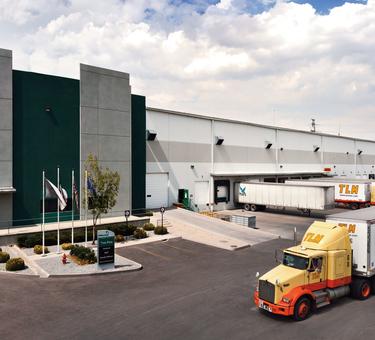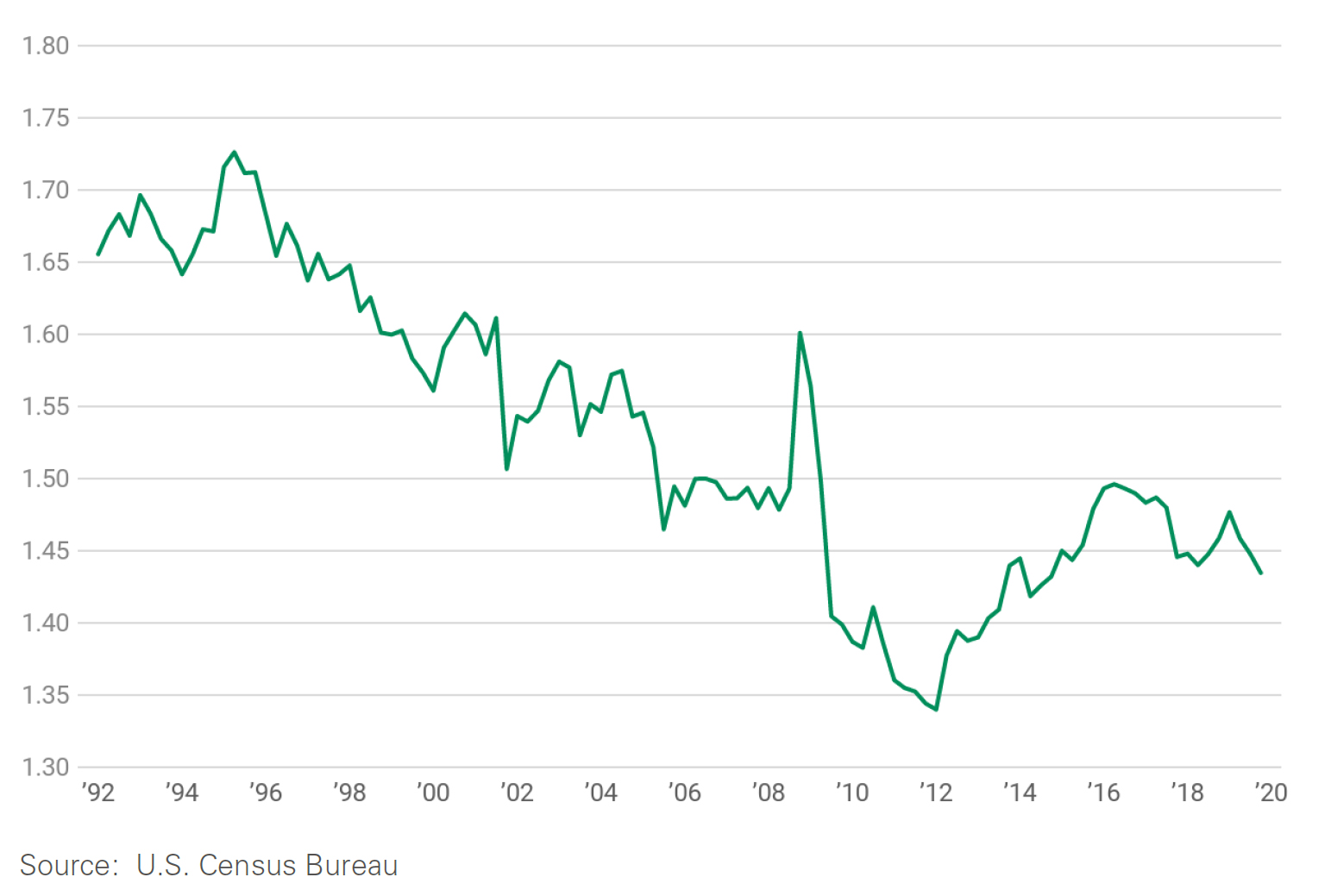In the fifth installment of our special series on COVID-19 and its implications for logistics real estate, we quantify the potential increase in long-term demand from higher inventory levels and accelerated e-commerce adoption in the third phase of the global pandemic, what we refer to as the “new normal.”
Introduction
Accelerated e-commerce adoption and higher inventory levels have the potential to generate 400 MSF or more of additional U.S. logistics real estate demand, or 150-200 MSF per year for two to three years.
- Re-tooling supply chains for increased e-fulfillment should create incremental net demand of 140-185 MSF in total.1 E-fulfillment demand should be highest in locations near end consumers, such as in Last Touch® and City
Distribution properties. - Inventories could increase by 5-10% in a bid for resiliency, producing 285-570 MSF of aggregate incrementaldemand.2 New demand from inventory growth could be spread more evenly throughout distribution networks.
Accelerated E-commerce Adoption Requires Investment in Distribution Capabilities
Each 100 bps of share shift from bricks and mortar to online translates to 46 MSF of net demand in the U.S. With the penetration rate already rising by 100-150 bps annually,3 March through mid-April’s e-commerce growth of 30%+4 suggests that the rate could rise by 300-400 bps in 2020, generating an incremental 140-185 MSF of net demand (accounting for cannibalization of bricks and mortar). Some of this demand has already surfaced in the race to respond to the coronavirus pandemic, but the reality of implementing this expansion in distribution capabilities may take more than a year to complete. In addition to growing retailer demand, parcel delivery and paper/packaging businesses should benefit from increased direct-to-consumer shipments. Service requirements and the need to optimize transportation costs will likely increase demand for Last Touch® and City Distribution facilities.
Faster e-commerce adoption should require greater supply chain investments from low-penetration industries such as grocery. Several customer industries are still in the early phases of e-commerce adoption, including Food & Beverage and Construction/Home Improvement. In recent weeks, grocers have announced 3-4x year-on-year increases in online sales. While all this growth may not be permanent, much could be as new adopters are now familiar with e-commerce and its convenience benefits. Growth in these categories will reinforce same- and next-day service requirements; if anything, legacy 3-5 day delivery capabilities were a barrier to adoption for these categories, where consumers typically have short planning horizons. These industries have relatively small e-fulfillment operations, and re-tooling supply chains will require substantial real estate investments. Third-party logistics specialists could benefit from this shift. Industries such as Diversified Retail and Electronics have much more established e-fulfillment operations but still enjoy high sales growth.
Exhibit 1
E-COMMERCE SHARE OF RETAIL SALES
E-COMM SHARE OF REVENUE |
|
| Food & Beverage | 2% |
| Auto Parts | 3% |
| Construction / Home Improvement | 9% |
| Healthcare | 12% |
| Consumer Products | 15% |
| Home Goods | 16% |
| Apparel | 24% |
| Diversified Retail | 27% |
| Sporting Goods | 28% |
| Electronics / Appliances | 33% |
Note: As of 2019
Source: Euromonitor, U.S. Census
Higher Inventories Could Produce Substantial Demand Tailwinds
Each 100 bps of growth in inventories is estimated to require an additional 57 MSF of U.S. logistics demand. Returning the retailer inventories-to-sales ratio from 1.45 to the 1990’s average of 1.65 would require inventory growth of 15%, holding sales constant.5 While this likely represents the high-end of the potential response, the pandemic has laid bare the trade-offs supply chains have made in tuning for efficiency. They were unable to serve customers and as a result lost revenue. Holding additional inventory is manageable for all customers and relatively easy to implement. In addition, carrying costs will remain low given record-low interest rates. We modeled 5-10% inventory growth, which would produce additional space needs of 285-570 MSF in the U.S. We expect this shift to lead to broad-based logistics real estate demand growth, with an emphasis on large consumer populations, access to transportation and modern facilities.
Exhibit 2
INVENTORIES-TO-SALES RATIO, RETAILERS
Many customers are likely to build higher inventory levels to ensure resilient supply chains. Several customer groups stand out for having very lean supply chains at present, including Food & Beverage, Electronics/Appliances, Healthcare and Diversified Retail. In the “new normal,” the logistic real estate demand created by a re-assessment of ideal inventory levels could be concentrated in customer industries that held little buffer stock pre-COVID.
Exhibit 3
INVENTORIES-TO-SALES RATIO
RATIO |
|
| Food & Beverage | 0.7 |
| Healthcare | 1.1 |
| Packaging / Paper | 1.2 |
| Electronics / Appliances | 1.3 |
| Diversified Retail | 1.4 |
| Consumer Products | 1.6 |
| Construction / Home Improvement | 1.7 |
| Home Goods | 1.8 |
| Auto Parts | 2.0 |
| Department Stores | 2.2 |
| Sporting Goods | 2.2 |
| Apparel | 2.2 |
| Industrial / Machinery | 2.7 |
Source: U.S. Census Bureau
Stay-at-Home Economy Outperformers Should Drive Post-COVID Reconfiguration
Grocery, Healthcare, Consumer Products and Diversified Retail are among top segments poised for lasting e-commerce impact and/or inventory re-assessment. Accounting for approximately one-third of the Prologis portfolio, these customer groups already represent an overweight portion of the logistics real estate customer base, relative to the overall economy, and should be well-positioned for outperformance throughout the recovery period.6 As a result, we expect adjustments to supply chains could happen quickly as uncertainty abates in the “new normal.”
New Sourcing Practices Could Create New Consumption Centers
Planning for future disruptions could gradually push many industries toward a greater diversity of manufacturing locations, including on- and near-shoring. While the production process generates much less logistics demand than the consumption end of supply chains, shifting production locations could create new consumption centers that will need to be serviced by logistics real estate customers across many industry segments. Low-cost production centers such as Mexico and Central and Eastern Europe are beginning to see increased interest. These changes—being more costly and complex than the relatively simple distribution network shifts detailed above—are likely to be a long-term trend that plays out over years.
Conclusion
We expect that lessons learned from the pandemic will add demand tailwinds to logistics real estate in the “new normal.” Prologis Research estimates that 400 MSF or more of total additional U.S. logistics real estate demand will be created in the next two to three years as companies adjust to higher e-commerce volumes and higher inventory levels. Growth in direct-to-consumer delivery volumes and rapid replenishment needs should continue to emphasize the appeal of logistics real estate that is closer to end consumers.
Endnotes
1. Based on $5.5T 2019 retail sales, of which 100 bps is $55B in retail sales. Intensity of use as follows: 1.168 MSF per billion for online and 328 KSF per billion in-store (840 KSF net per billion).
2. Based on coefficients from a 2-factor OLS regression of real retailer inventories and real retail sales on U.S. logistics real estate demand growth, spanning from 1992 to 2019.
3. U.S. Census Bureau Quarterly E-commerce Report
4. Rakuten Intelligence
5. Retailer inventories to sales ratio, U.S. Census Bureau, 1990s average from 1992 to 1999, as data reporting begins in 1992.
6. For more detail, see https://www.prologis.com/logistics-industry-research/customer-resilienceamid-high-economic-volatility.

